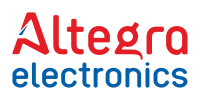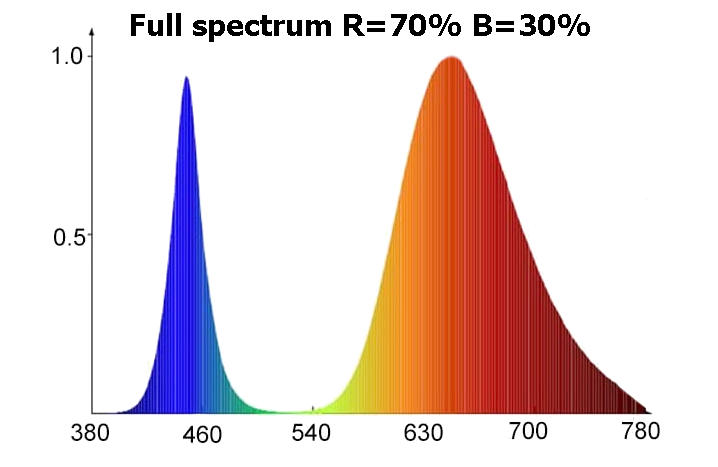Initially, the term "full spectrum" described the only true source of light in the full spectrum, the sun. Full-spectrum growth LED light is the latest evolution of a widely confused term.
Over time, this term began to acquire other properties of sunlight. Commercial lighting marketing has started using the name “full spectrum” to sell lighting sources with a color rendering index (CRI) above 90. At high CRIs, people perceive colors more accurately, much like how we see colors in nature, in daylight. This is a very beneficial feature for the human environment, e.g. offices or outdoor spaces, and often mandatory as design studios or exhibitions related to visual exposition, and so on. With the advent of crop lighting, LED manufacturers have started borrowing this term again. But this time, they argued that full-spectrum LEDs could reproduce the effects of sunlight on plants. This is how the growth light of full-spectrum LEDs was born.
About energy consumption and price differences of LED lighting equipment
Manufacturers of LED growth lighting equipment are trying to simplify the technical information provided to the buyer, thus distorting the facts. The most common explanation is that the efficiency of one or another light source is 0.85. To believe literally this should mean that 85% of the energy consumed becomes light although this is not true. Energy consumption and light emissions are mainly influenced by two main factors.
1. Power supply efficiency.
2. Efficiency of the LED light source (emitter).
Both of these factors should be as high as possible and the total useful amount of light is determined by the multiplication of these factors.
Since the primary purpose of an LED source is to illuminate - i. radiating light energy rather than heat we cannot measure only the power consumed by the LED light source and describe the quality of the LED lighting equipment accordingly.
We will perform several calculations to illustrate the true usefulness of LED lighting.
In principle, it does not matter which units of measurement we will use because all units of measurement can be converted from one to another knowing the secondary criteria (distance, time, area). Lux, Lumens, Watts, PPFD, w/cm2 and so on. so in the example we will give the calculation in watts W.
Let's say our light source consumes 1000w of power from the AC network, and the efficiency of the power supply that converts AC energy to DC and feeds LEDs is 88%, so after the power conversion supply to the LED only 880W of total consumed power reaches which, according to marketing, would mean 0.88. Such a statement is far from correct because the next part of the circuit is the LED emitters that convert the incoming energy into light (photons) and into excess heat. The problem is that the efficiency of LED emitters quite rarely exceeds 20-25%. This means that only 20-25% of the energy remaining after the power supply will turn into useful light, all other energy will turn into heat that we do not need. If we say that our LED is 25% efficiency means from the remaining 880w power 220w will turn into light, all other energy will turn into unwanted heat so the more accurate efficiency of such lighting equipment can be calculated as: 220w remaining optical power divided by 1000w total power consumption = 0.22, which means 22% total efficiency.
It should be noted that the LED emitters mentioned in the example with an efficiency of 25% should be high-quality components with a sufficiently high price, which significantly increases the overall price of the LED light source. Cheap LEDs often do not exceed 10% efficiency.
We will do 2 calculations when we supposedly need 20W light output
In the first case, it will be a cheap 82% efficiency power supply and a cheap 11% efficiency LED emitters.
1.a. Required 20W / LED efficiency 0.11 = LED emitters total power consumption 181.818W
1.b. LED power required 181.818 / Power supply efficiency 0.82 = 221.73W total power consumption from AC mains.
In the second case, it will be a high-quality 94% efficiency power supply and very high quality 32% efficiency LED emitters.
2.a. RRequired 20W / LED efficiency 0.32= LED emitters total power consumption 62.5W
2.b. LED power required 62.5W / Power supply efficiency 0.94 = 66.49W total power consumption from AC mains.
These calculation examples perfectly illustrate that the amount of light obtained by luminaires of different qualities can vary three or more times with the same amount of energy consumed. This also explains the large differences in the price of plant lighting equipment
As all the remaining energy is converted into heat, the use of low-quality equipment requires additional ventilation and, in some cases, even air conditioning, which in turn can increase the total electricity consumption by at least two more times.
How sunlight absorption works in plants
Photosynthesis depends on the light absorption of photo receptors and pigments in the leaf of plants. The best known of these pigments is chlorophyll-a, but there are many additional pigments that also contribute to photosynthesis. The relative light absorption of chlorophyll pigments is one of the reasons why red light has become popular in LED growth lighting. Because plant photo receptors also have their own light absorption ranges, they together regulate the processes that create the shape and structure of plants, depending on the resulting spectrum mixture. For example, a higher blue light ratio can lead to stronger root growth, more favorable plant biochemistry, and a stronger structure. However, these effects may not be as pronounced when more red light is turned on. Thus, the ever-changing spectrum of the sun constantly signals plants to change their shape and structure in response to natural environmental conditions. In order for plant photosynthesis to take place, only a light range of 400-700 nanometers is required, so when choosing a light source, it is worth paying more attention to the efficiency of the source than to the light spectrum.
Information you should know
Many LED lighting enthusiasts say that full-spectrum LED lighting is the best choice for growing plants because they mimic natural sunlight, and their main argument goes something like this:
Plants have been growing in the sun for millions of years. Why should we change what Mother Nature knows best?
Answer:
Maybe not, but the truth is that the so-called full-spectrum LED growth modules do not replicate the solar spectrum.
We don’t want to spark a new discussion, just below the facts on what the spectrum of sunlight looks like and how the spectrum of so-called full-spectrum LED lighting modules.
|
|
|
First of all, it is important to know that plants and people perceive light very differently. The photoreceptors in the human eye characterize light in terms of intensity and color. These photo receptors are very sensitive to green wavelengths and much less sensitive to blue and red wavelengths. Therefore, the lumen measurement unit was designed based on the flux of light visible to the human eye (road lighting, workplace or office lighting, etc.). Thus, the number of lumens indicates the amount of light relative to the sensitivity of the human eye at different wavelengths. Lux (lumen / m²) is a measure of intensity used to describe the number of lumens distributed over a surface of 1 m².
Unlike the human eye, plants use virtually all wavelengths from 400 to 700 nm for photosynthesis. Studies show that the relationship between plant wavelength and energy uptake is not as pronounced as that of the photoreceptors in the human eye. Photosynthetically Active Radiation - PAR used for Horticultural measurement
Because plants are slightly more sensitive to blue and red, measurements in lumens and lux should not be used to describe natural or artificial light in the growth zone of plants.
What is a full spectrum growth LED?
Full-spectrum LED growth light is simply a marketing term meaning that LED light for plants is very similar to sunlight, but in practice this statement is far enough from reality. This marketing term is derived from the concept of "full spectrum light", which is used to describe electromagnetic radiation from UV and infrared rays. Unfortunately, plant lighting is not that simple.
Misunderstandings regarding full-spectrum LED lighting information are most commonly found online
The concept of full-spectrum LED cultivation lighting raises many questions, and is particularly misleading for beginners. This is largely due to the fact that the terms and statements used do not correspond to reality and sales marketing distorts information and terms even more in an effort to make its product unique. This terminology has so far made sense to lighting designers looking to sell luminaires for ambient lighting, but plants need light to feed, grow and live.
In conclusion, it should be mentioned that:
- Full-spectrum LED lighting is by no means suitable for plant growth, it is simply lighting in which plants can grow, so it is not worth discussing the spectrum and its properties too much.
- Full-spectrum grow LEDs do not reproduce sunlight
- If you are not a professional vegetable grower for several years trying to get one extra percentage of production from a fixed area unit and competing in the vegetable growing market, we recommend to pay more attention to the efficiency of LED lighting equipment rather than the radiated spectrum.





